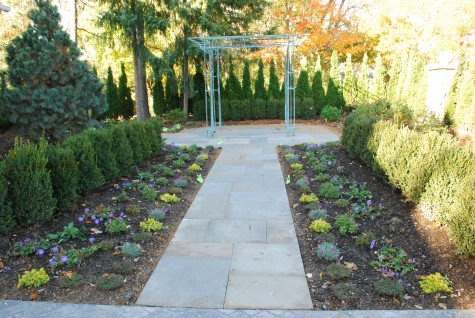 Just the words perennial border are enough to evoke visions of classical English gardens-breathtaking in width, and astonishing in length. Lavish. Believe me, if I could, I would have one, or five or twenty perennial borders each the size of a landing strip. Big enough to grow stately stands of every perennial I took a fancy to. There would be room for everything, from alchemilla to verbascum; I would winter giant tubs of Zantedeschia Aethiopica in number 6 loggia. I would grow peonies like crops. I would enlarge every and any border, on the slightest whim. I would have acres in meadow studded with fruit trees, and a wildflower garden the size of a football field. I would have a giant barn for tools, and a lunchroom that could comfortably seat the fifty gardeners I would need to have help me maintain it all. But my reality is much more about small urban gardens; these perennial gardens ask for some solid dreaming attended by careful editing.
Just the words perennial border are enough to evoke visions of classical English gardens-breathtaking in width, and astonishing in length. Lavish. Believe me, if I could, I would have one, or five or twenty perennial borders each the size of a landing strip. Big enough to grow stately stands of every perennial I took a fancy to. There would be room for everything, from alchemilla to verbascum; I would winter giant tubs of Zantedeschia Aethiopica in number 6 loggia. I would grow peonies like crops. I would enlarge every and any border, on the slightest whim. I would have acres in meadow studded with fruit trees, and a wildflower garden the size of a football field. I would have a giant barn for tools, and a lunchroom that could comfortably seat the fifty gardeners I would need to have help me maintain it all. But my reality is much more about small urban gardens; these perennial gardens ask for some solid dreaming attended by careful editing.
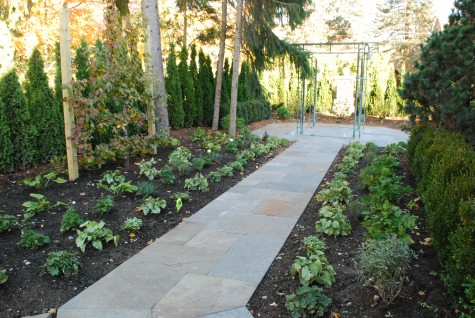 This very small L-shaped garden will very much have the feeling of a large garden, as big percentage of the square footage of the yard is devoted to perennials. The house has something of a feel of a cottage, so though the planting is regular, the plant varieties are placed in casually determined numbers. Towards a good, but not fixed, beat. The house is a very beautiful blue grey color; my first editing step was to consider color. The major tree in the yard-pinus flexilis “Vanderwolf’s”; the needles are distinctly blue. An underplanting of hosta krossa regal is a contrast in texture with much the same color. A blue hybrid of Panicum Virgatum will back up and loosen up the Carefree Beauty roses. The intersection of the bluestone walk is marked by a terrace, and a copper pergola blue with age. The blues rule here.
This very small L-shaped garden will very much have the feeling of a large garden, as big percentage of the square footage of the yard is devoted to perennials. The house has something of a feel of a cottage, so though the planting is regular, the plant varieties are placed in casually determined numbers. Towards a good, but not fixed, beat. The house is a very beautiful blue grey color; my first editing step was to consider color. The major tree in the yard-pinus flexilis “Vanderwolf’s”; the needles are distinctly blue. An underplanting of hosta krossa regal is a contrast in texture with much the same color. A blue hybrid of Panicum Virgatum will back up and loosen up the Carefree Beauty roses. The intersection of the bluestone walk is marked by a terrace, and a copper pergola blue with age. The blues rule here.
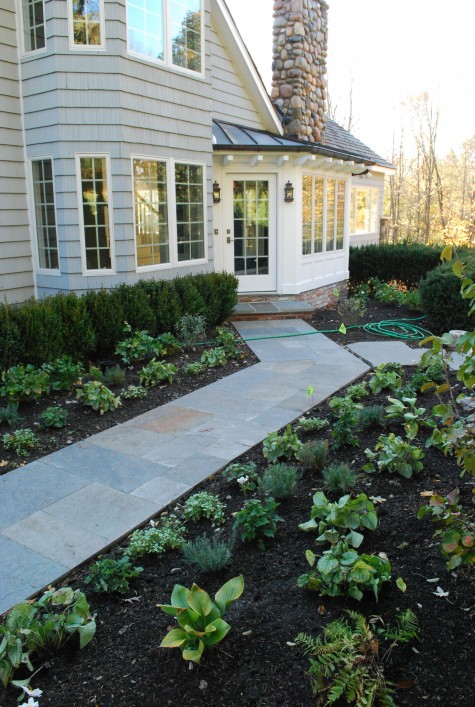 The west border is frosty in color; Jack Frost brunnera, Lamium white Nancy, Japanese painted ferns, white Japanese anemone; I threw in a few flax and Salvia May night in the sunniest and driest spots. This border may not be 10 feet deep, but relative to the overall space, the borders are generously configured.
The west border is frosty in color; Jack Frost brunnera, Lamium white Nancy, Japanese painted ferns, white Japanese anemone; I threw in a few flax and Salvia May night in the sunniest and driest spots. This border may not be 10 feet deep, but relative to the overall space, the borders are generously configured.
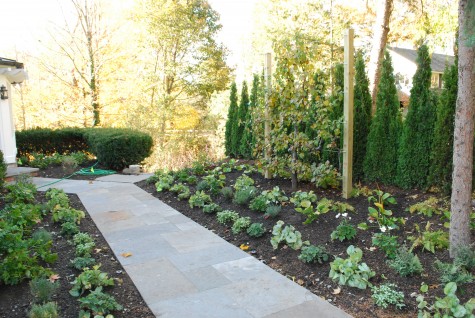 The star of the west border-a Bradford pear trained as a espalier. It is an old plant, but the branches are not yet sturdy enough to maintain their shape without a form. The posts will be stained the same color as the house. Providing privacy in the yard is the arborvitae “DeGroot’s Spire”. The small and fine texture of the needles is appropriate for a small space. Once they establish, I will prune off the spire part. This arborvitae takes well to a geometric pruning. I would like to see them kept at 10 feet with a flat face-a green wall.
The star of the west border-a Bradford pear trained as a espalier. It is an old plant, but the branches are not yet sturdy enough to maintain their shape without a form. The posts will be stained the same color as the house. Providing privacy in the yard is the arborvitae “DeGroot’s Spire”. The small and fine texture of the needles is appropriate for a small space. Once they establish, I will prune off the spire part. This arborvitae takes well to a geometric pruning. I would like to see them kept at 10 feet with a flat face-a green wall.
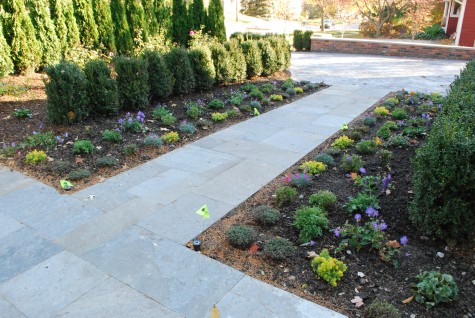
The north walk off the drive is home to two generously wide perennial borders, enclosed by a tall hedge of Green Mountain boxwood. These borders feature Salvia May Night, a dwarf monarda and geranium Rozelle; the remaining space is given to a mix of angelina, dianthus and thyme. Wide and low, this border will feature the ground plane, and make the space look spacious. On the far side of the drive, limelight hydrangeas and Venus dogwoods will make the garden entirely private from the neighboring house.
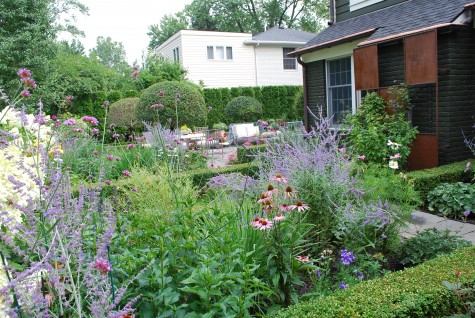 Perennial borders occupy a lot of space at maturity. A new garden with tall perennials is guaranteed to look sparsely planted the first year, and stuffed the third year. That big and wild look can warm up a small space like nothing else can. I always find someplace to plant a few verbena bonariensis-so the big garden looks airy, and not heavy.
Perennial borders occupy a lot of space at maturity. A new garden with tall perennials is guaranteed to look sparsely planted the first year, and stuffed the third year. That big and wild look can warm up a small space like nothing else can. I always find someplace to plant a few verbena bonariensis-so the big garden looks airy, and not heavy.

When your John Cabot rose gets to this age, changes have to be made. I planted this rose 20 years ago; this perennial garden has changed dramatically over the years. Some perennials faded-some thrive. The trees have changed the pattern of sun and shade as they have aged. Unlike a tree, a perennial garden changes dramatically over that length of time. Given this volatility, I try to edit in favor of perennial plants with a propensity to be healthy; long season interest, good habit, interesting foliage and reasonable maintenance, and reliable bloom count for a lot too. There are good reasons not to plant plenty of perennials, should your space be really small. That said, there will likely be room for those perennials that only pass the “I cannot live without it” muster; why do without them?
Leave a Comment